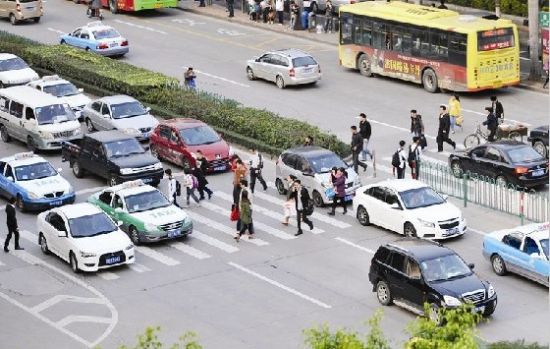


By Liu Jingyue
May 31, 2013
On May 23, Shenzhen introduced tough new rules in order to discourage the "Chinese style of crossing the road (中国式过马路).” On the day the new rules were introduced, nearly 3,000 people were caught violating them by 1,300 police standing guard at various intersections throughout the city. Of those caught, 2,000 people were issued a fine.
The “Chinese style of crossing the road” is a Chinese expression that refers to the behavior of Chinese pedestrians crossing an intersection, not based on the traffic signals, but by whether there are a sufficient number of pedestrians who feel it’s safe to cross. Such behavior often poses a danger to both drivers and pedestrians themselves. Although such behavior isn't unique to China, traffic conditions and intersection designs in China have made the behavior more rampant here than in many other countries around the world.
Since May 23, pedestrians in Shenzhen who jaywalk can either be issued a fine of up to 100 yuan, or become a volunteer at an intersection for up to 60 minutes. The penalty given in each circumstance depends upon the nature of the offence. Those who refuse to cooperate can be detained by police.
While the new rules appear harsh, their desired effect has not been forthcoming. One week on, the “Chinese style of crossing the road” can still be seen at major intersections throughout the city.
Shenzhen is not the first city in China to introduce rules in order to discourage such behavior. Municipalities and provinces all over China - including Beijing municipality and Hebei, Henan, Inner Mongolia and Hainan provinces - have introduced similar regulations in previous months in an attempt to discourage the "Chinese style of crossing the road."
While some believe the behavior is “culturally rooted” in that Chinese have little respect for rules and law, others believe China's traffic system is the major cause. Putting police at intersections and issuing fines is not going to make the situation better, the latter argue.
In general, road designs in China aim to maximize traffic flow. They make little consideration for pedestrians. A major reason for this is the large number of cars on China's roads - a number that keeps growing. On average, 20 million new cars are added to China's roads each year. As a result, roads are widened and waiting times for pedestrians become too long to bear.
A major problem facing pedestrians is a rule which allows traffic to turn left or right when the green signal permitting pedestrians to cross a road begins. As a result, cars get in the way of pedestrians as they try to cross the road. According to a survey by Tongji University, 30 percent of pedestrians at major intersections in Hangzhou have been blocked by right-turning vehicles, leaving them no choice but to cross a road during a red signal.
Moreover, pedestrians in China also have to endure long waiting times at major intersections. The Tongji University survey found the average Chinese pedestrian can wait up to 70 to 90 seconds for a signal permitting them to cross a road. At major intersections in Hangzhou, pedestrians can wait more than 100 seconds for the signal.
Such designs can hardly be seen as pedestrian friendly. It’s easy to understand why pedestrians, when not offered sufficient time and protection to cross a road in accordance with the rules, cross the road in an unsafe manner.
In addition to penalizing pedestrians, the Chinese government should assist them. To begin with, the government could install countdown clocks - found in Hong Kong and many other parts of the world - at all traffic lights, so that pedestrians can make better judgments.

